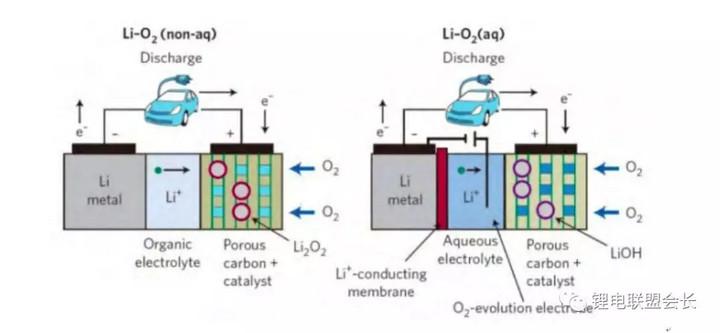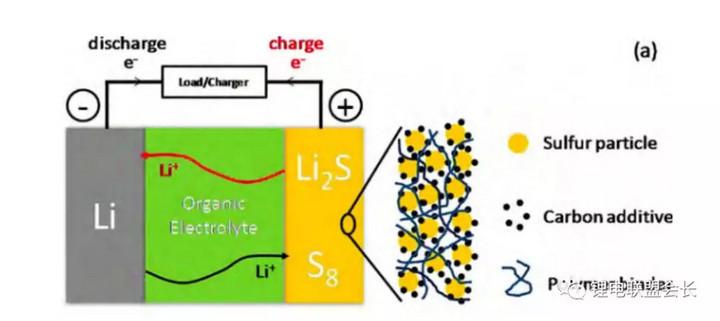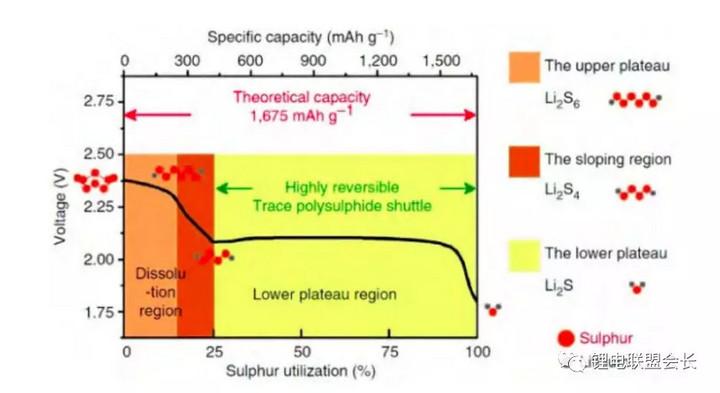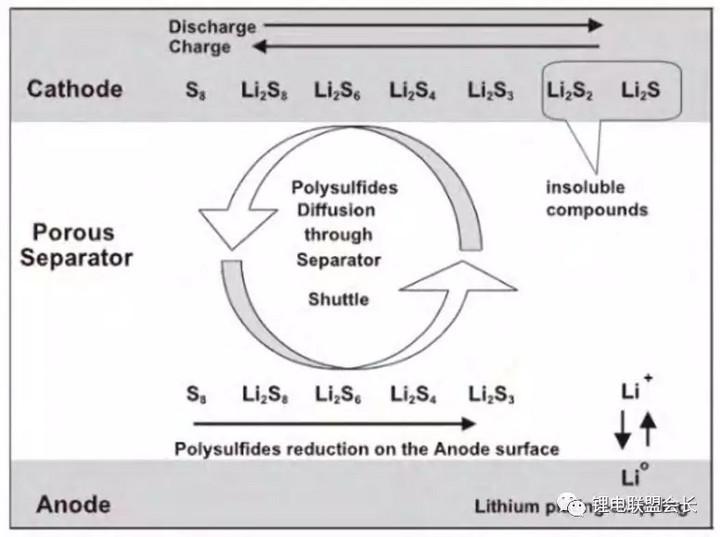Lithium air batteries and lithium sulfur batteries
Oct 09, 2019 Pageview:1148
China's energy storage net news: the present lithium ion battery research focus is mainly on lithium air battery and lithium sulfur batteries, both are considered to be the most potential for development of a new generation lithium battery. Them instead of lithium ion battery cathode material on the structure and reaction mechanism have very big distinction.
1. Lithium air batteries
Lithium air batteries is one of the metal air batteries, due to the use of the lowest molecular weight lithium metal as the active material, its theoretical specific energy is very high.Don't calculate oxygen quality of 11140 wh/kg, in fact the available energy density also can reach 1700 wh/kg, far higher than other battery system.The basic structure and working mechanism of the lithium air batteries as shown in the figure below.
Lithium air batteries by the use of the electrolyte status is different, the main can be divided into water system, the organic system, water - organic hybrid system and solid-state lithium air batteries.In organic system lithium air batteries work, internal material O2 through porous air electrode into the battery, the electrode surface is catalytic into O2 - or O22 - and then combine with Li + in the electrolyte, lithium generating peroxide (Li2O2) or lithium oxide (Li2O), product deposition in the air electrode surface.When all the air in the air electrode hole is blocked by the product after the battery discharge end.The electrode reaction is shown below:
The positive: O2 + e - li + 2 + 2?Li2O2;O2 + 4 e - + 4 li +?2 li2o
Negative: Li?Li++ e -
The total response: 2 li + O2?Li2O2 (2.96 V);4 li + O2?2 li2o (2.91 V)
Lithium air batteries has incomparable ultra-high energy density, environment friendly, and the price is low wait for an advantage, but its research is the primary stage, so many thorny problems, mainly include:
(1) the positive reaction requires a catalyst.Discharge process, in the absence of the presence of catalyst and oxygen reduction is slow;Platform in the process of charging voltage is 4 v or so, easy to cause the electrolyte decomposition and side effects.Need to use the appropriate catalyst to help cell reaction.
(2) lithium air batteries is an open system, can cause such as electrolyte volatilization, electrolytic liquid oxygen and moisture in the air and CO2 react with metallic lithium and so on a series of fatal problem.
(3) the air electrode channel congestion problem.Discharge generated does not dissolve in the electrolyte Li2O and Li2O2 will pile up in the air electrode, blocking the air channel, in air electrode deactivation, discharge end.
To sum up, the lithium battery has a lot of problems to be solved in the air: including the oxygen reduction reaction of catalysis, hydrophobic oxygen electrode through air, the air electrode deactivation.Although lithium air batteries has made some progress, but real application still has a long way to go.
2. Lithium sulfur batteries
Lithium battery research originating in the 1970 s, but the actual capacity of lithium sulfur batteries have been is not high, severe attenuation, has not taken seriously.2009, LindaF. Nazar group reported that sulfur carbon compounds as lithium battery cathode material for better circulation and high discharge capacity, raised a hot wave of lithium battery research.Lithium sulfur batteries is mainly used in elemental sulfur or harvard for battery cathode materials, anode main use metal lithium, its battery structure as shown.
With the anode materials for elemental sulfur (mainly the S8 ring form), its theoretical specific capacity is 1675 mah/g, theoretical discharge voltage of 2.287 V, theoretical energy density is 2600 wh/kg.When charging and discharging, electrode reaction is shown below:
The positive: the S8 (s) + e - li + 2 + 2?Li2S8;
Li2S8+2e-+2Li+?2Li2S4;
Li2S4+2e-+2Li+?2Li2S2(s);
Li2S2(s)+2e-+2Li+?2Li2S(s)
Negative: Li?Li++ e -
Total reaction: the S8 e - (s) + 16 + 16 li +?8 li2s (s)
Lithium sulfur batteries, the reaction of the anode materials is more than one electron, multi-step reaction step by step, as shown.
Sulfur discharge process, for example, simple can be divided into two stages, first of all, solid elemental sulfur S8 Li2S8 with Li + liquid, with the deepening of the degree of discharge will be after soluble Li2S6 eventually generate soluble Li2S4, corresponding to the voltage of 2.4 V to 2.1 V platform, the process with the formation of liquid material, reaction rate faster.Then with further discharge, at 2.1 V voltage platform, soluble Li2S4 into insoluble solid phase Li2S2, and eventually to generate end-products of solid-phase Li2S, due to the solid start generating in this stage, makes the ion diffusion is slow, so the reaction speed is slower.Different from traditional material of lithium ion batteries, lithium battery charge and discharge of elemental sulfur and sulfide sulfur intermediate after polysulfide lithium Li2Sx (x = 2-8) and not by lithium ion in anode material and anode materials for embedding and embedded off back and forth between the charge and discharge, thus lithium-sulfur battery performance affected by positive electrode material of lithium ion to take off the embedded ability.
Advantages of lithium sulfur batteries are very obvious: has very high theoretical capacity;No oxygen, the material will not produce oxygen evolution reaction, so it is good security;Sulfur resources and elemental sulfur price is very low;Environmentally friendly, low toxicity.But lithium sulfur batteries real application is faced with some problems, mainly including:
Poor: (1) conductivity and guide lithium sulfur molecules in the elemental sulfur in 8 S are linked together to form coronary S8, belongs to the typical electron, ion insulators, the conductivity at room temperature is only 5 x 10 to 30 S/cm.Product and Li2S2 and Li2S also be electrical insulators.And utilization of active material is not high, the rate of poor performance.At present mainly through the preparation of small size of sulfur carbon composite material to solve the electrical conductivity of the lithium sulfur batteries battery anode materials and conducting lithium sexual problems.
Shuttle effect: (2) polysulfide lithium sulfur in the lithium battery charge and discharge process, the long chain of polysulfide lithium Li2Sx (4 "x 8) or less will dissolve into the electrolyte, through the diaphragm, achieve the reduction of the cathode and short chain polysulfide lithium Li2Sx (< 2 x 4 or less), and not soluble Li2S2, Li2S, corrosion of the cathode.Soluble of polysulfide lithium can also through the diaphragm returned to the anode, shuttling back and forth the phenomenon known as the shuttle effect of polysulfide lithium, as shown.This effect will cause the self-discharge of active material of lithium sulfur batteries, cause material coulomb efficiency is not high.
(3) the volume expansion problem: when fully charged into lithium sulfide, sulfur 76% volume expansion, easy to cause the structure of the anode materials are destroyed, influence the stability of the active material, cause capacity attenuation.
(4) lithium metal anode: because of the sulfur itself does not contain lithium atoms, so must use lithium metal elemental as anode materials, but inevitably produce so lithium dendrite problem, bring safe hidden trouble.
Although lithium sulfur batteries still exist some problems, in recent years, with the deepening of the research on lithium sulfur batteries, particle size by reducing sulfur, sulfur materials for coating, preparation of lithium sulfur carbon composite materials, for polysulfide absorption, improve a variety of measures, such as the electrolyte in improving the capacity of sulphur materials and circularity has made a lot of progress.
In the past thirty years,Lithium electricityPool has experienced rapid development, which represented by lithium ion battery system of secondary battery has become the power source of various small portable electronic equipment, electronic products has been heavily promoted by the development of smart phones, tablets, digital cameras, laptops and other portable devices to widely spread.With the continuous development of society, secondary battery in the increasing demand of large electric equipment, but given a theory of the anode material in lithium ion battery limit value is low, in the power supply system of large electric equipment limited.Lithium battery and lithium battery air system, as a new generation of secondary battery has very high theoretical specific capacity value, get the earnest attention of researchers and secondary battery market, however, the current lithium air batteries and lithium battery research is still in the development stage, in addition to the specific capacity of battery cathode materials and need to further improve the stability, safety critical problems, such as batteries are to be solved.For the understanding of the working principle of the lithium battery cathode material, which is helpful in grasping the core of this kind of battery research problems, mastering the battery cathode material development.
The page contains the contents of the machine translation.
- Prev Article: The effect of temperature on several kinds of lithium batteries
- Next Article: What about the battery model of electric vehicle?
Leave Message
Hottest Categories
-
Hottest Industry News
-
Latest Industry News









